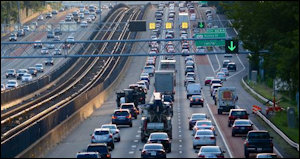 Northern Virginia transportation officials will try an interesting experiment to help cope with traffic disruptions during construction of the $2.3 billion Interstate 66 widening project — they will allow commuters to sign up and pay for van-pool services through a smartphone app. Reports the Washington Post:
Northern Virginia transportation officials will try an interesting experiment to help cope with traffic disruptions during construction of the $2.3 billion Interstate 66 widening project — they will allow commuters to sign up and pay for van-pool services through a smartphone app. Reports the Washington Post:
“This is not just new technology for the area, it is also new technology and service in an area that has been a bit of a desert for transit options,” said Chuck Steigerwald, director of strategic planning at the Potomac and Rappahannock Transportation Commission (PRTC), which oversees a regional van-pool service and runs commuter buses from Prince William to Washington.
The apps will be critical, he said, to encouraging people to use transit and van-pool services during peak construction on the I-66 expansion, a project that also aims to change the way people move along the corridor.
The PRTC is planning to launch a free, on-demand microtransit service from the Gainesville and Haymarket neighborhoods to OmniRide commuter lots starting next summer. PRTC officials say the agency will develop an app to connect riders to rides. The $1.1. million project will provide transportation from residential areas to bus stops for commuters who don’t take the bus because of the challenges of using park-and-ride lots, which are already at capacity, officials said.
The funding will cover the cost of a software interface that will allow vehicle operators to respond to commuter requests with dynamic, real-time routing. It also will pay for vehicles, onboard vehicle hardware, transit operations and advertising of the services.
In another high-tech effort, the PRTC is creating a platform for a flexible van-pool program that will connect riders with van pools and facilitate payment of fares. The $317,600 project will enable the use of the technology to potentially transform the way van pools operate in Northern Virginia, said Robert Schneider, executive director of the PRTC.
Bacon’s bottom line: It’s good to see Northern Virginia transportation officials experiment with new technology. Persuading more commuters to use vans and buses is potentially the most cost-effective way to squeeze more capacity out of the region’s overloaded transportation arteries.
There’s more to a successful ride-hailing service like Uber and Lyft, though, than just connecting people with rides via smart phone. Ride-hailing companies have sophisticated algorithms to predict when and where ridership demand will materialize and where to pre-position vehicles to serve that demand. As demand waxes and wanes and moves around, these companies respond nimbly. Will PRTC be able to go with the (traffic) flow? We’ll see.
Another question is whether riders will avail themselves of van pools for the convenience of reaching park-and-ride lots. Might they not prefer to ride a van directly to their destination (or very close to it) rather than to a park-and-ride lot where they then shift to another transportation mode? Will they see enough of a value-add proposition to make it worth their while?
Finally, I wonder if PRTC ever considered the option of contracting directly with Uber, Lyft or another third-party company to come up with creative solutions. The Washington Post article doesn’t tell us.
Still, I don’t see how this initiative can hurt. The worst case scenario is that commuters don’t respond. In the context of a $2.3 billion construction project, the cost is peanuts. On the positive side, things just might work out as hoped. If we’re ever going to improve our transportation system, we need to make lots of small, inexpensive experiments, discard the losers, and scale up the winners. You don’t know if something will work until you try it. There is nothing wrong with failure — as long as government acknowledges the failures, shuts them down quickly, and moves on.


